- Home
- Michael Pollan
A Place of My Own: The Education of an Amateur Builder Page 7
A Place of My Own: The Education of an Amateur Builder Read online
Page 7
It is no coincidence that the type of landscape richest in opportunities for prospect and refuge is the savanna, where it is thought that the species evolved. For an upright, ground-dwelling biped, these flat or gently rolling grassy plains, punctuated by bodies of water and copses of trees, are at once abundant in visible sources of food and water and relatively safe: From the shade of the trees, one can look out over a great expanse of land with little risk of detection. Sociobiologists like Wilson suggest that a predisposition toward our optimum primordial habitat survives in the form of a pronounced aesthetic preference for savanna-like landscapes—evident in the design of our parks, picturesque gardens, and suburbs.
In his collection of lectures The Symbolism of Habitat, Appleton demonstrates the importance of symbols of prospect and refuge in the history of landscape painting and architecture. A pleasing landscape painting or garden, he maintains, will be one that offers both kinds of symbols, along with some visual means of traveling from one to the other. Among the symbols of refuge he mentions are trees, copses, caves, and buildings; horizons, hills, and towers function as symbols of prospect, and paths or roads serve to link the two kinds of imagery, facilitating the viewer’s exploration of the scene. The picturesque painters and landscape designers were masters of the symbolism of habitat, Appleton contends, and this is why their ideas and creations have endured.
Whether our attraction for the symbolism of habitat is a matter of biology or simply an old and successful habit, Appleton’s theory does help account for the gravitational attraction we feel toward certain kinds of landscapes—and, specifically, for the attraction I felt for my site. For certainly the clearing by the rock offered a high degree of prospect and refuge. Any rock this big affords a sense of refuge, and this particular rock—at the wooded edge of a field, and overlooking a pond—offered fine prospects as well. On my next visit to the site, I decided to try to see it through Paleolithic eyes. The perspective of a twentieth-century hunter was the best I could manage, but I could easily imagine such a person crouched down close to the rock, peering unseen into the lower field or down toward the pond, where grazing animals would be apt to congregate. Prospect and refuge, seeing without being seen: this was the very essence of my site.
So could it be my site had the sanction of the human genome itself? Maybe my instinct about the place (my first instinct, that is, not the subsequent one that drove me into the stacks) was the voice of some dim primordial urge—maybe, in other words, it was not merely a metaphorical instinct but the actual genetic mechanism that governs human habitat selection. It’s hard for me to think of myself as being even remotely in touch with such a thing (hence instinct number two). But perhaps this is where Charlie’s campsite test comes in: The exercise of trying to imagine a place as a safe spot to sleep is a way of putting us in closer touch with any deep, atavistic impulses we might feel about it. For what is camping, after all, but a temporary reversion to the life of the hunter-gatherer? Sleeping outdoors, beyond the envelope of civilization and technology, instantly renders the value of prospect and refuge vivid once again.
At first it seemed uncanny to me that the three different perspectives I’d tried out on my site could have overlapped so closely. Yet of course if the scientific perspective is correct, and there is some biological basis for our landscape preferences, we should probably not be too surprised that cultures as different from one another as Ming Dynasty China and Augustan England would have developed vocabularies that find so many similar things to praise in a landscape: Both may be articulating the same deep attractions.
Yet what confirmed me in my choice finally was no one test, but the very fact that all three perspectives—science and art and mysticism—had evidently concurred: this uncanny, almost mystical alignment of theories and metaphors. The analysis to which I subjected my site may have had all the trappings of rational inquiry, and I suppose I brought the proper enlightenment skepticism to bear on the process, but in the end what was I really doing? Hunting for a patch of sacred ground on which to build, and an authority—or, in my case, three authorities—to consecrate it, to say, Yes, this clearing in the woods is the right place.
I figured that if the artist, the geomancer, and the scientist all agree, then maybe this place was really as special as it felt. None of them may possess the “truth” about what makes a good site, but together they represent a couple thousand years of human experience of the land, which might be as close to the truth of the matter as I could hope to get.
It’s possible that this almost magical sense of place I’ve been describing is an anachronism, something we will overcome as we accustom ourselves to the Enlightenment idea of space that Thomas Jefferson was advancing with his great grid—the powerful concept that space is the same everywhere, that it’s continuous, centerless, edgeless, and organized in strict adherence to the laws of Euclidean geometry. Someday we may feel perfectly at home on the big Cartesian grid, giving our addresses in x, y, and z coordinates.
And yet powerful as this notion of space is, I’ve discovered it doesn’t rhyme very well with the body’s own experience of space, whether riding the dragon or simply sitting in a chair. The testimony of our senses seems adamant that space is full of interruptions and breaks and places qualitatively different one from another—places that seem to us special, if not magical. All the vocabularies of place I consulted, and the long human experience they represent, concur in the conviction that space is in fact discontinuous, that place is sometimes found and not made—that there is finally something more than a modernist’s glass jar giving structure to the landscape. Something like these bodies of ours.
That jar of Wallace Stevens’s notwithstanding, ever since the day I stumbled on this site it has felt like a place I found rather than chose. Sitting out here on a summer afternoon in this sweet, sweet spot of shade, raising up around me these four imaginary walls and perfecting in imaginary rafters the roof of arching boughs that partially shelters me already, the sense that here is a good place to be, to build, seems a fact fully as real, as given, as the big rock sitting here beside me. How could I ever have doubted it? I may have come to this knowledge the long way around, but now I understood—knew in my bones!—what the farmer’s dumbest cow had understood without a moment’s bovine reflection. This is the place.
CHAPTER 3
On Paper
1. WORDS
By now you have probably noticed a tendency of mine to lean rather heavily on words and theories in my dealings with the world. How else to account for my inability to pick a spot for a building without recourse to a half-dozen books and three different theories of site selection? And yet it was partly in order to get away from words that I was attracted to the idea of building something with my own hands in the first place.
“Information overload” is something we hear a lot about these days, and there does seem to be a growing sense that technology, the media, and the sheer quantity of information in circulation have somehow gotten between us and reality—what used to be called, without a lot of quotation marks or qualifiers, nature. This may not be a new phenomenon—it was more than a century ago, after all, that Thoreau went to Walden to recover the “hard bottom…we can call reality” from the “mud and slush of opinion” that obscured it—but the situation does seem to have gotten worse. Not only is the mud and slush of opinion a lot thicker now that it’s being piled on by so many different media, but our most famous philosophers (think of Jacques Derrida or Richard Rorty) are telling us that, underneath it all, there may not be any reality to recover—that it’s mud and slush all the way down.
I suffer from an acute case of the contemporary malady, one that probably goes back to a time before people had coined terms like “information overload” and “media saturation” or thought to attach the word “virtual” to “reality.” I remember as a teenager reading that Marshall McLuhan had likened opening the Sunday paper to settling into a warm bath. The metaphor delivered a tiny jolt of recognition,
because I too found reading—reading almost anything—to be a vaguely sensual, slightly indulgent pleasure, and one that had very little to do with the acquisition of information. Rather than a means to an end, the deep piles of words on the page comprised for me a kind of soothing environment, a plush cushion into which sometimes I could barely wait to sink my head. More often than not, I could remember almost nothing the moment I lifted myself out of the newspaper or magazine or paperback in which I’d been immersed. Not that I usually bothered to try. Mostly I just let the print wash over me, as if it were indeed warm water, destined to swirl down the drain of my forgetfulness.
So it’s probably not surprising that I should have grown up to be a magazine editor and a writer, someone who might reasonably be described as a professional producer of bathwater for others. But even after long days spent editing copy or writing, I never go anywhere without packing something to read. I’m pained to be caught on the subway without a book or a periodical, and if by accident I should find myself in so naked a state, I’ll commence reading over my seatmate’s shoulder—newspapers, potboilers, bibles swaddled in plastic slipcovers—or I’ll study the back pages of the tabloids arrayed in front of me, a less-than-perfect medium that nevertheless has been the source of most of what I know about sports. I’ll read just about anything, in fact, before I’d even think to glance at the face of the person seated across the car or otherwise engage the parade of humanity before me.
I’m afraid it doesn’t stop there. It’s all I can do to resist the urge to steal a few paragraphs while I’m in the car, pumping gas, or walking down the street (three challenges I’ve met), and even when I’m in social or intimate situations where reading is unquestionably a poor idea. More than once, Judith has caught me as my eyes reached for a line of print right in the middle of a big heart-to-heart.
You can see why I might start to think this was a problem. I began to suspect that the gorgeous columns of words had indeed become a kind of cushion between me and the unwritten world, even a crutch. And then, a few years ago, the tiny voice whispering that I might be missing something spending so much of my time in the tub was amplified by a sentence I read (on the subway, as it happened) in a book by Hannah Arendt, a sentence that kept coming back to me as a kind of rebuke. “Nothing perhaps is more surprising in this world of ours,” the philosopher wrote, “than the almost infinite diversity of its appearances, the sheer entertainment value of its views, sounds, and smells, something that is hardly ever mentioned by the thinkers and philosophers.” At first, this sentence struck me as being poignant, even profound. But then, with this piercing sense of deflation, I realized that anybody who regarded this observation as anything but obvious—as anything but pathetically obvious—had a serious problem.
And that included me. To make matters worse, I didn’t have the excuse of being a thinker or a philosopher to fall back on. I was just a magazine editor, a mid-level producer and consumer of bathwater who spent most of his working days neck-deep not only in “the mud and slush of opinion” but in information and statistics, images and arguments, even in opinions about opinion—meta—mud and slush, you could say. So perhaps it was inevitable that sooner or later the prospect of doing something more directly involved with the “views, sounds, and smells” of this world would become attractive to me, if not a matter of some therapeutic urgency. Plato, who was of course famously distrustful of all worldly appearances, wrote that in order to open the eyes of the mind we first had to close the eyes of the body. I wanted to go some distance the other way, hoping by a spell of unfamiliar and worldly work to open the eyes of the body, if only by a squinty crack.
Anyone who works with words and symbols every day will know what I’m talking about—it is the same impulse that fills the streams with anglers every April, the nurseries with gardeners, and the hardware stores with do-it-yourself carpenters. Though it turns out the matter is never quite that simple. Because no sooner have you declared your allegiance to some corner of the physical world than you discover a long, alluring shelfful of relevant books and periodicals, word upon word of irresistible how-to that it is suddenly imperative to consult. I confess that part of the appeal for me of first gardening and then carpentry were the vast new uncharted realms of print—the countless books and periodicals and mail-order catalogs—these pastimes opened up for my delectation. It is not easy, getting past words.
Yet that is what I felt a growing desire to do, and what attracted me to making a building in particular. For building seemed to me to be one of the most tangible, and grounded, and factual things that human beings do—the closest we ever come to making something on the order of nature, something with the sheer, incontrovertible presence of a tree or a rock. Instead of turning away from “worldly appearances,” I would see if I couldn’t make one of them myself. The work of building seemed to hold out the promise of at least a partial cure for my addiction to print, for this sense of living at too great a remove from the things of this world and the life of the senses. As it turned out I wasn’t entirely wrong about this, though I was more than a little naïve.
The process of designing my building began with more words, however. The best way I could think of to convey my dream for the place to Charlie was in writing. So a few weeks after I had settled on the site, I wrote him a long letter outlining what I thought my needs were and describing as best I could the building taking shape in my head. The words in this letter, along with all the other words we exchanged in the weeks to come, comprised an informal version of what architects call the program: the list of requirements and wishes that motivates any architectural undertaking. In the simplest terms, the task before Charlie was to design a form—a building—that would mediate between the desires set forth in my words on the one hand, and the facts of the site on the other.
My experience of the site, sitting out there on my chair, approaching the place time and again and considering its prospects, had deepened my sense of the building I wanted. It had begun as a simple, two-dimensional picture, something to improve a view, but by now the image of the building in my mind’s eye had acquired an interior and its own point of view, and it was this that I tried to describe in my letter. There was now a long desk at one end of a rectangular room that faced in the direction of the house, taking in the pond between the trees, the garden, and the path back to the porch. Above the desk I pictured a big window. Visible from the house, this wall would constitute the building’s most public face, though I pictured the door going on the opposite wall, where it wouldn’t interfere with the desk; putting it on the back wall would also force you to walk around the big rock before entering the building, which seemed like a good way to approach it.
Sitting there at my imaginary desk, mentally swiveling around in my chair, I considered what else I wanted in the room. Plenty of bookshelves. A stove of some kind. A place for Judith to sit. Also high on the list was a daybed—a cozy spot to read or snooze. But how do you make a cozy spot in a one-room hut? I pictured the daybed carved into a thick wall, a niche enveloped by bookshelves or cabinets. My image here probably came from Monticello, which I’d recently visited. Jefferson sandwiched his bed in between two rooms, so that it forms a deep, snug pocket in the wall, which he could enter from either side. I had only one room to work with here—this had to be a simple building, I stressed to Charlie, if I was going to build it myself. (The word “simplicity” appears several times in the letter, usually underlined.) But what if we made one of the walls abnormally thick? The depth of a bookcase, say. This would give us a space the daybed could be fitted into, creating at least a partial sense of enclosure. A thick wall or two would also provide plenty of spaces to hold my books and other things. Part of my image of this place was that it would be meticulously organized, with everything I required built in or easily stowed—“boatlike,” is how I put it in the letter to Charlie. There was no question that my streamlined new workspace was conceived under the sign of Getting Organized.
“I picture a
space no bigger than it has to be,” I wrote in the letter, “single in purpose and shipshape, with a specific, dedicated place for everything. We should think of the interior less as a room, in fact, than as a piece of furniture, or maybe a cockpit.” I emphasized that the wall unit needn’t be fancy—that it might even be part of the building’s frame, use its plywood sheathing for its back. Thick walls would also serve to warm up the room, it seemed to me, by creating an intermediate space, a kind of buffer, between the inside and the outside of the building. This might make the place feel somewhat less exposed than you would expect a hut set out in the woods to feel, give it a stronger sense of refuge.
Yet there was something a little odd about this wish for thick walls, because at the same time I entertained what seemed like a completely contradictory image of the building as a place radically open to the landscape—as a room that, by virtue of its size and site, could be on far more intimate terms with nature than the house was. I asked Charlie for lots of operable windows—at least one on each wall—and even a small porch or deck where I might sit outside and read when it got too warm indoors. I guess I had very different winter and summer images of the place. Charlie would have to sort this out.

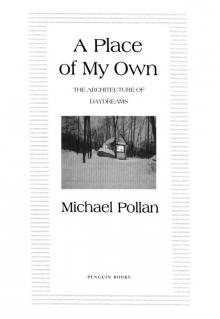 A Place of My Own: The Education of an Amateur Builder
A Place of My Own: The Education of an Amateur Builder Cooked: A Natural History of Transformation
Cooked: A Natural History of Transformation The Omnivore's Dilemma
The Omnivore's Dilemma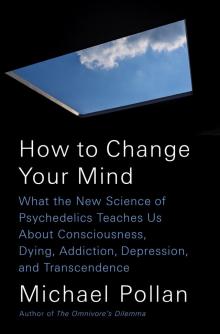 How to Change Your Mind
How to Change Your Mind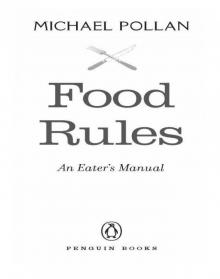 Food Rules
Food Rules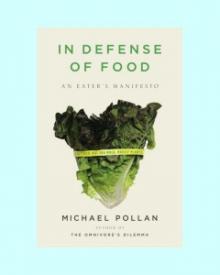 In Defense of Food
In Defense of Food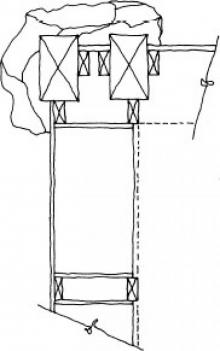 A Place of My Own
A Place of My Own